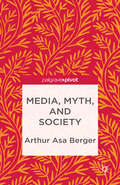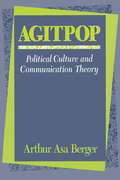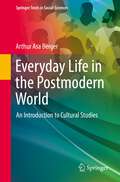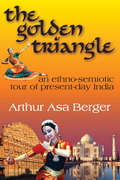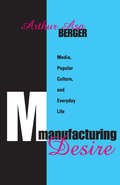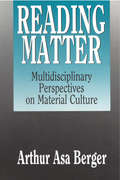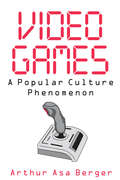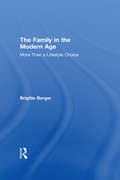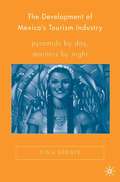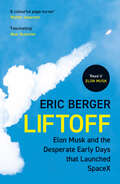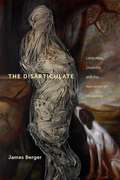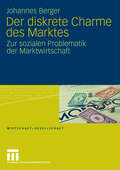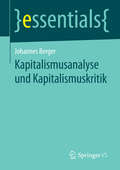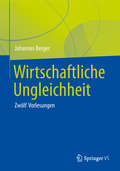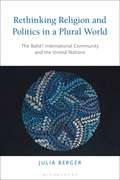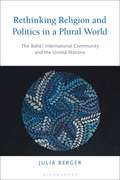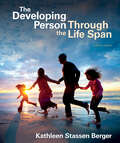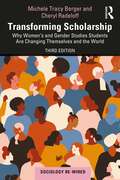- Table View
- List View
Media, Myth, and Society
by A. BergerUsing a cultural approach to classical myths, this book examines how they affect psychoanalytic theory, historical experience, elite culture, popular culture, and everyday life. Berger explores diverse topics such as the Oedipus Myth, James Bond, Star Wars, and fairy tales.
Agitpop: Political Culture and Communication Theory
by Arthur Asa BergerIn this entirely sophisticated and scholarly account of political culture, Arthur Asa Berger shows how the variety of cultural preferences creates the foundations of communication theory. Using the work of Aaron Wildavsky, the author shows how individualism, egalitarianism, collectivism, and fatalism form the basis of culture in complex societies. But more importantly, Berger breaks down the mechanical distinction between mass culture and elite culture, showing how they interpenetrate and crossover at the level of competitive and hierarchical frames. Agitpop, now in paperback, suggests that there is an ideological content to our popular culture, even though the creators no less than the consumers of that culture are either unaware or dimly aware that they are creating works with an ideological bent. The work takes up in quick order two examples from different areas of the hierarchical, individualist, egalitarian, and fatalist cultures. From football games to the Iran-Contra Hearings, from MTV to the Human Potential Movement, from Max Headroom to humor on the Jews, and from wrestling to The Terminator, Berger takes up his master themes with a deft touch of his own. Weaving in the work of scholars from Emile Durkheim to Aaron Wildavsky he manages to make each of the chapters very much his own. For those who know the earlier work of this author, the reader will be very much at home; for those new to Berger, the volume will be a joyous revelation. The final three chapters reveal a deeper aspect of Berger's work. His interpretation of the earlier materials in terms of the semiotics of power, of textual analysis, or deconstruction of the media, and finally, an analysis and self-analysis of the larger research agenda of which this work is pivotal, should make this book central to the theoretical construction of popular and political culture. For people working in communications theory, political culture, and the sociology of knowledge, this book is a must; for everyone els
Agitpop: Political Culture and Communication Theory
by Arthur Asa BergerIn this entirely sophisticated and scholarly account of political culture, Arthur Asa Berger shows how the variety of cultural preferences creates the foundations of communication theory. Using the work of Aaron Wildavsky, the author shows how individualism, egalitarianism, collectivism, and fatalism form the basis of culture in complex societies. But more importantly, Berger breaks down the mechanical distinction between mass culture and elite culture, showing how they interpenetrate and crossover at the level of competitive and hierarchical frames. Agitpop, now in paperback, suggests that there is an ideological content to our popular culture, even though the creators no less than the consumers of that culture are either unaware or dimly aware that they are creating works with an ideological bent. The work takes up in quick order two examples from different areas of the hierarchical, individualist, egalitarian, and fatalist cultures. From football games to the Iran-Contra Hearings, from MTV to the Human Potential Movement, from Max Headroom to humor on the Jews, and from wrestling to The Terminator, Berger takes up his master themes with a deft touch of his own. Weaving in the work of scholars from Emile Durkheim to Aaron Wildavsky he manages to make each of the chapters very much his own. For those who know the earlier work of this author, the reader will be very much at home; for those new to Berger, the volume will be a joyous revelation. The final three chapters reveal a deeper aspect of Berger's work. His interpretation of the earlier materials in terms of the semiotics of power, of textual analysis, or deconstruction of the media, and finally, an analysis and self-analysis of the larger research agenda of which this work is pivotal, should make this book central to the theoretical construction of popular and political culture. For people working in communications theory, political culture, and the sociology of knowledge, this book is a must; for everyone els
Everyday Life in the Postmodern World: An Introduction to Cultural Studies (Springer Texts in Social Sciences)
by Arthur Asa BergerThis introductory textbook familiarizes students with ideas of key thinkers and perspectives related to postmodern thought and everyday life. The book is unique in that it offers selections from key passages of works of important thinkers as well as from some of the author's own publications that serve as examples of how to interpret various aspects of culture. The book draws in readers with its engaging and conversational style and use of cases, illustrations and photographs, including fun discussions on everyday life under pandemic restrictions. This is a must read for students taking courses in sociology, cultural anthropology, culture and media studies, linguistics, social philosophy, and for specific courses on postmodernism.
The Golden Triangle: An Ethno-semiotic Tour of Present-day India
by Arthur Asa BergerThis book offers a semiotically informed ethnographic study of contemporary culture in Rajasthan and India. It adapts the methodology of analyzing cultures found in Roland Barthes' semiotic portrait of Japanese culture, "Empire of Signs", but adds an analysis of lifestyles as explicated in the work of social anthropologist Mary Douglas, political scientist Aaron Wildavsky, and a number of other social scientists. This manuscript is, at first, a guide to Rajasthan and India, and it is that but it is also more in that it considers tourism from both an anthropological and sociological level.Berger begins with statistics on tourism and other aspects of life in Rajasthan and India, and then considers how tourism in India compares with tourism in other important tourism destinations. He refers to the "Imaginary India" as the picture created in tourists' minds with the help of guidebooks, media, and the Internet before they actually travel to India. He then discusses these representations and how they are actually different from the country itself. The trip itself then becomes the search for the authentic India - the goal is to find places before they are discovered. He calls this "Semiotic Rajasthan," where the representations are compared to actuality.After offering a discussion of semiotic theory, it interprets and analyzes a number of important aspects of Rajasthani and Indian culture such as: the Taj Mahal, the Palace of Winds in Jaipur, the notorious rat temple in Deshnok, and sacred cows. Lastly, he discusses his own trip and how the impact of Rajasthan did not fully register until he returned home.This manuscript's strength lies in the author's ability to write in an accessible manner, assemble the project in an interesting way, and include only that information which will guide the reader along the narrative trail. While this manuscript really is a guidebook to Rajasthan, it could also serve as a good introduction to ethnography for beginning students and an interested general audience. It moves from basic explanations, such as that of semiotics, to complex applications all with the grace of good story telling.
The Golden Triangle: An Ethno-semiotic Tour of Present-day India
by Arthur Asa BergerThis book offers a semiotically informed ethnographic study of contemporary culture in Rajasthan and India. It adapts the methodology of analyzing cultures found in Roland Barthes' semiotic portrait of Japanese culture, "Empire of Signs", but adds an analysis of lifestyles as explicated in the work of social anthropologist Mary Douglas, political scientist Aaron Wildavsky, and a number of other social scientists. This manuscript is, at first, a guide to Rajasthan and India, and it is that but it is also more in that it considers tourism from both an anthropological and sociological level.Berger begins with statistics on tourism and other aspects of life in Rajasthan and India, and then considers how tourism in India compares with tourism in other important tourism destinations. He refers to the "Imaginary India" as the picture created in tourists' minds with the help of guidebooks, media, and the Internet before they actually travel to India. He then discusses these representations and how they are actually different from the country itself. The trip itself then becomes the search for the authentic India - the goal is to find places before they are discovered. He calls this "Semiotic Rajasthan," where the representations are compared to actuality.After offering a discussion of semiotic theory, it interprets and analyzes a number of important aspects of Rajasthani and Indian culture such as: the Taj Mahal, the Palace of Winds in Jaipur, the notorious rat temple in Deshnok, and sacred cows. Lastly, he discusses his own trip and how the impact of Rajasthan did not fully register until he returned home.This manuscript's strength lies in the author's ability to write in an accessible manner, assemble the project in an interesting way, and include only that information which will guide the reader along the narrative trail. While this manuscript really is a guidebook to Rajasthan, it could also serve as a good introduction to ethnography for beginning students and an interested general audience. It moves from basic explanations, such as that of semiotics, to complex applications all with the grace of good story telling.
Manufacturing Desire: Media, Popular Culture, and Everyday Life
by Arthur Asa BergerThe average person in America watches four hours of television per day and spends the equivalent of nine years of his or her life in front of the television set. If the attention most people devote to popular culture - listening to the news, watching soap operas, reading the comics-were added up, it would reveal that most people spend an enormous amount of time with popular culture which becomes in large measure, their culture. "Manufacturing Desire" is a study of how the mass media broadcast or spread various popular arts; further how the media and popular arts play a major role in shaping our everyday lives.The television shows we watch, the movies we see, the radio programs we listen to, and all the comic strips we read influence social behavior. They give us ideas about what is good and evil, about how to solve problems, and about how we should relate to others. If we understand this, says Berger, then the way we think about our media-influenced culture will be far different than if we see popular culture as mindless entertainment. Berger provides an analysis of the way popular culture and the mass media simultaneously reflect and affect various aspects of American culture and society. He examines commercials, television shows, comics, film, humor, and everyday life in terms of what beliefs and values are found in them, what attitudes toward ourselves, and our societies are contained in them, how they achieve their effects, and what they reflect about present-day American culture and society.This book is analysis of the impact mass media have across America, cross-culturally, and internationally. "Manufacturing Desire" will provide the general reader as well as specialists in communication and information, sociology, and psychology with a better understanding of the effects of mass media and popular culture on contemporary society.
Manufacturing Desire: Media, Popular Culture, and Everyday Life
by Arthur Asa BergerThe average person in America watches four hours of television per day and spends the equivalent of nine years of his or her life in front of the television set. If the attention most people devote to popular culture - listening to the news, watching soap operas, reading the comics-were added up, it would reveal that most people spend an enormous amount of time with popular culture which becomes in large measure, their culture. "Manufacturing Desire" is a study of how the mass media broadcast or spread various popular arts; further how the media and popular arts play a major role in shaping our everyday lives.The television shows we watch, the movies we see, the radio programs we listen to, and all the comic strips we read influence social behavior. They give us ideas about what is good and evil, about how to solve problems, and about how we should relate to others. If we understand this, says Berger, then the way we think about our media-influenced culture will be far different than if we see popular culture as mindless entertainment. Berger provides an analysis of the way popular culture and the mass media simultaneously reflect and affect various aspects of American culture and society. He examines commercials, television shows, comics, film, humor, and everyday life in terms of what beliefs and values are found in them, what attitudes toward ourselves, and our societies are contained in them, how they achieve their effects, and what they reflect about present-day American culture and society.This book is analysis of the impact mass media have across America, cross-culturally, and internationally. "Manufacturing Desire" will provide the general reader as well as specialists in communication and information, sociology, and psychology with a better understanding of the effects of mass media and popular culture on contemporary society.
Reading Matter: Multidisciplinary Perspectives on Material Culture
by Arthur Asa BergerTo be civilized involves, among other things, making, using, and buying objects. Although speculation on the significance of objects often tends to be casual, there are professionals--anthropologists, historians, semioticians, Marxists, sociologists, and psychologists--who analyze material culture in a systematic way and attempt to elicit from it reliable information about people, societies, and cultures. One reason that analyzing objects has been problematical for scholars is the lack of a sound methodology governing multidisciplinary research. Reading Matter addresses this problem by defining a comprehensive set of methodological approaches that can be used to analyze and interpret material culture and relate it to personality and society.Berger offers discussions of the main concepts found in semiotic, historical, anthropological, psychoanalytic, Marxist, and sociological analysis. He provides practical descriptions of the working methods of each discipline and demarcates their special areas of investigation. Berger's lively discussions include a wealth of illustrative examples that help to clarify the complex and often difficult theories that underlie interpretations of material culture. In the second part of his analysis, Berger uses these disciplines to investigate one subject--fashion and an important aspect of fashion, blue jeans, and what the author calls the denimization phenomenon. Here he shows how different methods of reading material culture end up with different perspectives on things--even when they are dealing with the same topic.The author's focus is on the material culture of post-literate societies and cultures, both contemporary and historical. This comparative approach enables the reader to trace the evolution of objects from past to present or to see how American artifacts spread to different cultures, acquiring a wholly new meaning in the process. Reading Matter is an important contribution to the study of popula
Reading Matter: Multidisciplinary Perspectives on Material Culture
by Arthur Asa BergerTo be civilized involves, among other things, making, using, and buying objects. Although speculation on the significance of objects often tends to be casual, there are professionals--anthropologists, historians, semioticians, Marxists, sociologists, and psychologists--who analyze material culture in a systematic way and attempt to elicit from it reliable information about people, societies, and cultures. One reason that analyzing objects has been problematical for scholars is the lack of a sound methodology governing multidisciplinary research. Reading Matter addresses this problem by defining a comprehensive set of methodological approaches that can be used to analyze and interpret material culture and relate it to personality and society.Berger offers discussions of the main concepts found in semiotic, historical, anthropological, psychoanalytic, Marxist, and sociological analysis. He provides practical descriptions of the working methods of each discipline and demarcates their special areas of investigation. Berger's lively discussions include a wealth of illustrative examples that help to clarify the complex and often difficult theories that underlie interpretations of material culture. In the second part of his analysis, Berger uses these disciplines to investigate one subject--fashion and an important aspect of fashion, blue jeans, and what the author calls the denimization phenomenon. Here he shows how different methods of reading material culture end up with different perspectives on things--even when they are dealing with the same topic.The author's focus is on the material culture of post-literate societies and cultures, both contemporary and historical. This comparative approach enables the reader to trace the evolution of objects from past to present or to see how American artifacts spread to different cultures, acquiring a wholly new meaning in the process. Reading Matter is an important contribution to the study of popula
Video Games: A Popular Culture Phenomenon
by Arthur Asa BergerFrom their inception, video games quickly became a major new arena of popular entertainment. Beginning with very primitive games, they quickly evolved into interactive animated works, many of which now approach film in terms of their visual excitement. But there are important differences, as Arthur Asa Berger makes clear in this important new work. Films are purely to be viewed, but video involves the player, moving from empathy to immersion, from being spectators to being actively involved in texts. Berger, a renowned scholar of popular culture, explores the cultural significance of the expanding popularity and sophistication of video games and considers the biological and psychoanalytic aspects of this phenomenon.Berger begins by tracing the evolution of video games from simple games like Pong to new, powerfully involving and complex ones like Myst and Half-Life. He notes how this evolution has built the video industry, which includes the hardware (game-playing consoles) and the software (the games themselves), to revenues comparable to the American film industry.
Video Games: A Popular Culture Phenomenon
by Arthur Asa BergerFrom their inception, video games quickly became a major new arena of popular entertainment. Beginning with very primitive games, they quickly evolved into interactive animated works, many of which now approach film in terms of their visual excitement. But there are important differences, as Arthur Asa Berger makes clear in this important new work. Films are purely to be viewed, but video involves the player, moving from empathy to immersion, from being spectators to being actively involved in texts. Berger, a renowned scholar of popular culture, explores the cultural significance of the expanding popularity and sophistication of video games and considers the biological and psychoanalytic aspects of this phenomenon.Berger begins by tracing the evolution of video games from simple games like Pong to new, powerfully involving and complex ones like Myst and Half-Life. He notes how this evolution has built the video industry, which includes the hardware (game-playing consoles) and the software (the games themselves), to revenues comparable to the American film industry.
The Family in the Modern Age: More Than a Lifestyle Choice
by Brigitte Berger"Many argue that the modern family is an anachronistic institution whose demise is only a question of time. Looking to the family's future, the eminent sociologist Brigitte Berger argues that despite being weakened and embattled, the family will survive as a fundamental social institution. The family has been the cradle of the modern social order for some three hundred years, and will remain the basis for any society concerned with happiness, liberty, equality, and prosperity for all its members. Rather than being condemned to the dust heap of history, or becoming a simple lifestyle choice, the modern family has a number of enduring strengths that will ensure its survival. In The Family in the Modern Age, Berger focuses on four major areas of concern. First, she demonstrates that the short shrift given to the institutional dimension of the family misrepresents the importance and the role of the family today. Second, she documents the close cognitive fit between core elements of the modern family and the stability of modern society, and argues that any society that ignores this connection does so at its own peril. Third, Berger investigates the degree to which currently identified problems may endanger the modern family's vital individual and social functions. And finally, she develops reasonable projections of the future of the family that will be core elements contributing to the creation of a politically democratic and economically prosperous world. Berger takes a long-range view of ""the career"" of the conventional family in the twentieth century. Her perspective is distinctly different from that widespread in scholarly literature today. She takes account of recent demographic shifts in behavior relating to sexuality, marriage, family structure and values, relationships, and family functions. Berger considers hotly contested contemporary issues relating to the family-gay marriage, divorce, abortion, women and work, issues of child-care, among others. Bu"
The Family in the Modern Age: More Than a Lifestyle Choice
by Brigitte Berger"Many argue that the modern family is an anachronistic institution whose demise is only a question of time. Looking to the family's future, the eminent sociologist Brigitte Berger argues that despite being weakened and embattled, the family will survive as a fundamental social institution. The family has been the cradle of the modern social order for some three hundred years, and will remain the basis for any society concerned with happiness, liberty, equality, and prosperity for all its members. Rather than being condemned to the dust heap of history, or becoming a simple lifestyle choice, the modern family has a number of enduring strengths that will ensure its survival. In The Family in the Modern Age, Berger focuses on four major areas of concern. First, she demonstrates that the short shrift given to the institutional dimension of the family misrepresents the importance and the role of the family today. Second, she documents the close cognitive fit between core elements of the modern family and the stability of modern society, and argues that any society that ignores this connection does so at its own peril. Third, Berger investigates the degree to which currently identified problems may endanger the modern family's vital individual and social functions. And finally, she develops reasonable projections of the future of the family that will be core elements contributing to the creation of a politically democratic and economically prosperous world. Berger takes a long-range view of ""the career"" of the conventional family in the twentieth century. Her perspective is distinctly different from that widespread in scholarly literature today. She takes account of recent demographic shifts in behavior relating to sexuality, marriage, family structure and values, relationships, and family functions. Berger considers hotly contested contemporary issues relating to the family-gay marriage, divorce, abortion, women and work, issues of child-care, among others. Bu"
The Development of Mexico’s Tourism Industry: Pyramids by Day, Martinis by Night (New Directions in Latino American Cultures)
by D. BergerBerger argues that tourism was forged by Mexico's government in 1928 as the cornerstone of state-led modernization programmes. Berger presents tourism as the leading and influential facet of the post-revolutionary modernization programme. She also examines how tourism fostered nationalism and unity, and emerged as a new form of foreign diplomacy.
Liftoff: Elon Musk And The Desperate Early Days That Launched Spacex
by Eric BergerThe dramatic inside story of the first four historic flights that launched SpaceX—and Elon Musk—from a shaky startup into the world's leading edge rocket company.
The Disarticulate: Language, Disability, And The Narratives Of Modernity
by James BergerLanguage is integral to oursocial being. But what is the status of those who stand outside of language?The mentally disabled, "wild" children, people with autism and otherneurological disorders, as well as animals, infants, angels, and artificialintelligences, have all engaged with language from a position at its borders. In the intricate verbal constructions of modern literature, the'disarticulate'--those at the edges of language--have, paradoxically, playedessential, defining roles. Drawing on the disarticulate figures inmodern fictional works such as Billy Budd, The Sound and the Fury,Nightwood, White Noise, and The Echo Maker, among others,James Berger shows in this intellectually bracing study how these charactersmark sites at which aesthetic, philosophical, ethical, political, medical, andscientific discourses converge. It is also the place of the greatest ethicaltension, as society confronts the needs and desires of "the least of itsbrothers. " Berger argues that the disarticulate is that which is unaccountablein the discourses of modernity and thus stands as an alternative to theprevailing social order. Using literary history and theory, as well asdisability and trauma theory, he examines how these disarticulate figuresreveal modernity's anxieties in terms of how it constructs its others.
Der diskrete Charme des Marktes: Zur sozialen Problematik der Marktwirtschaft (Wirtschaft + Gesellschaft)
by Johannes BergerDie soziologische Gesellschaftstheorie ist bis auf den heutigen Tag von einer anhaltenden Skepsis gegenüber der Marktvergesellschaftung geprägt. Gemeinschaftsverlust, zunehmende Ungleichheit und empörende Ungerechtigkeiten sind bekannte Stichworte der Kritik an dieser historisch neuartigen Organisationsform der Wirtschaft. Die Denkanstöße dieser Kritik aufnehmend versucht dieser Band einen zumindest für die Soziologie ungewöhnlichen Blick auf die Marktwirtschaft zu werfen: Märkte befördern Gleichheit, indem sie Eintrittsbarrieren schleifen, die in Verbandsbildungen aller Art ihre Wurzel haben. Solche Eintrittsbarrieren sind eine zentrale Ursache materieller Ungleichheit. Internationale Entwicklungsunterschiede resultieren in erster Linie nicht aus unfairen Handelspraktiken, sondern aus der unterschiedlichen technologischen Leistungsfähigkeit von Nationen. Sie werden abgebaut, wenn entweder die weniger entwickelten Länder technologisch aufholen oder wenn bestehende Barrieren der Aneignung neuen Wissens beseitigt werden.
Kapitalismusanalyse und Kapitalismuskritik (essentials)
by Johannes BergerDer Kapitalismus, so hat Schumpeter gesagt, ist eine „Maschine der Massenproduktion, was unvermeidlich auch Produktion für die Massen bedeutet.“ Was immer man von diesem System halten mag: Kein anderes Wirtschaftssystem löst die Aufgabe, die Bevölkerung mit immer mehr und ständig neuen Konsumgütern zu versorgen, besser. Wie es aussieht, ist die Wohlstandsmehrung jedoch begleitet von materieller Ungleichheit, in ihrer Höhe schwankender Arbeitslosigkeit und ständig wiederkehrenden Wirtschaftskrisen. Zunächst wendet sich der Artikel den Grundzügen des modernen Kapitalismus zu. In einem zweiten Schritt wird dann der Gestaltwandel des Kapitalismus thematisiert. Im Anschluss daran wird die vielstimmige Kritik an diesem Wirtschaftssystem untersucht. Sie ist nicht nur Sozialkritik, sondern immer auch Kulturkritik gewesen. Der Beitrag schließt mit einem Ausblick auf die Zukunft dieses Wirtschaftssystems und skizziert denkbare, aber unwahrscheinliche Reformen, deren Verwirklichung in eine Wirtschaftsform jenseits der bestehenden führen würde.
Wirtschaftliche Ungleichheit: Zwölf Vorlesungen
by Johannes BergerIn den letzten Jahren ist soziale Ungleichheit immer mehr in das Zentrum der wissenschaftlichen und öffentlichen Aufmerksamkeit gerückt. Soziale Ungleichheit hat viele Gesichter, ihr harter Kern ist aber die Einkommensungleichheit. Die Vorlesungen beruhen auf der Auswertung der soziologischen, ökonomischen und politisch-philosophischen Literatur zu dem Thema und setzen sich zum Ziel, die wichtigsten theoretischen, empirischen und normativen Fragen zu beantworten, die durch den Tatbestand der Einkommensungleichheit aufgeworfen werden. Am Beginn steht die Klärung von Grundbegriffen (soziale Ungleichheit und Chancengleichheit), danach wendet sich die Vorlesung den vielfältigen Problemen der Messung wirtschaftlicher Ungleichheit zu. Im darauf folgenden Abschnitt werden die Grundlinien einer Theorie der wirtschaftlichen Ungleichheit skizziert. Abschließend geht die Vorlesung der Frage nach, wie sich die wirtschaftliche Ungleichheit auf nationaler und internationaler Ebene entwickelt hat. In den Anhängen werden spezielle Fragen behandelt, wie z.B. die verschiedenen Formeln für den Gini-Koeffizienten, die Mincersche Verdienstfunktion oder die Pareto-Verteilung. Die ZielgruppenDas Buch wendet sich an Sozialwissenschaftler und Wirtschaftswissenschaftler sowie an eine breitere, an der wissenschaftlichen Behandlung des Themas interessierte Öffentlichkeit. Der AutorJohannes Berger war bis 2004 Professor für Soziologie an der Universität Mannheim. Zwischen 2007 und 2012 Gastdozenturen an den Universitäten Konstanz, Münster und Göttingen.
Rethinking Religion and Politics in a Plural World: The Baha’i International Community and the United Nations
by Julia BergerIn this book, Julia Berger examines internal meaning-making structures and processes driving NGO behavior, identifying constructs from within a religious tradition that forge new ways of pursuing social change. She evaluates the operation of a distinct rationality, arguing that action is guided not simply by beliefs and values, but also by a combination of elements so intrinsic as to constitute an “organizational DNA.” These hidden structures and rationalities manifest themselves in new modes of engagement and agency; they help us to see the pivotal role of religion in shaping notions of peace, progress, and modernity. To demonstrate the operation and salience of such a rationality, Berger draws on the example of the worldwide Baha'i community. Emerging in 19th century Iran, the community's theological engagement with questions of justice, the unity of humankind, and the emerging global order, constitute one of the most distinct and compelling, yet least-researched examples of religious engagement with the pressing questions of our time. Analyzing events spanning a 75-year period from 1945-2020, this book provides a unique historical and contemporary perspective on the evolving role of religion and civil society in the modern world.
Rethinking Religion and Politics in a Plural World: The Baha’i International Community and the United Nations
by Julia BergerIn this book, Julia Berger examines internal meaning-making structures and processes driving NGO behavior, identifying constructs from within a religious tradition that forge new ways of pursuing social change. She evaluates the operation of a distinct rationality, arguing that action is guided not simply by beliefs and values, but also by a combination of elements so intrinsic as to constitute an “organizational DNA.” These hidden structures and rationalities manifest themselves in new modes of engagement and agency; they help us to see the pivotal role of religion in shaping notions of peace, progress, and modernity. To demonstrate the operation and salience of such a rationality, Berger draws on the example of the worldwide Baha'i community. Emerging in 19th century Iran, the community's theological engagement with questions of justice, the unity of humankind, and the emerging global order, constitute one of the most distinct and compelling, yet least-researched examples of religious engagement with the pressing questions of our time. Analyzing events spanning a 75-year period from 1945-2020, this book provides a unique historical and contemporary perspective on the evolving role of religion and civil society in the modern world.
The Developing Person Through the Life Span (Eleventh Edition)
by Kathleen BergerKathleen Bergers acclaimed survey of developmental psychology across the life span is up to date, inclusive of cultures from every corner of the globe, and compelling in the way it shows students the everyday relevance of the fields theories, ideas, and discoveries.
Transforming Scholarship: Why Women's and Gender Studies Students Are Changing Themselves and the World (ISSN)
by Michele Tracy Berger Cheryl RadeloffTransforming Scholarship offers an essential guide to one of the most richly rewarding yet often under-appreciated academic majors: Women's and Gender Studies. This fully updated and revised third edition answers the question of what you can do with a women’s and gender studies degree with resounding authority. Chapters include exercises and valuable point-of-view segments with recent graduates and academics to help students realize their many talents and passions and how these may be linked to future professional opportunities. Students are also encouraged to reflect on the ways in which their efforts in the classroom can be translated into a life guided by feminism, civic engagement, and activism with updates such as: A focus on activism that resulted from socio-political movements in the 2010s–2020, such as #BlackLivesMatter (BLM) and the #MeToo Movement; An examination of the impact of COVID-19 on the academic and socio-cultural environment and career opportunities for graduates; An exploration of increased acceptance of social justice and feminist perspectives; Highlighting of intersectional identities of WGST students and faculty. Transforming Scholarship is an ideal counterpart and companion for capstone courses in women’s and gender studies, and for those who have finished their degree and are looking for invaluable advice while pondering, "What’s next?"
Transforming Scholarship: Why Women's and Gender Studies Students Are Changing Themselves and the World (ISSN)
by Michele Tracy Berger Cheryl RadeloffTransforming Scholarship offers an essential guide to one of the most richly rewarding yet often under-appreciated academic majors: Women's and Gender Studies. This fully updated and revised third edition answers the question of what you can do with a women’s and gender studies degree with resounding authority. Chapters include exercises and valuable point-of-view segments with recent graduates and academics to help students realize their many talents and passions and how these may be linked to future professional opportunities. Students are also encouraged to reflect on the ways in which their efforts in the classroom can be translated into a life guided by feminism, civic engagement, and activism with updates such as: A focus on activism that resulted from socio-political movements in the 2010s–2020, such as #BlackLivesMatter (BLM) and the #MeToo Movement; An examination of the impact of COVID-19 on the academic and socio-cultural environment and career opportunities for graduates; An exploration of increased acceptance of social justice and feminist perspectives; Highlighting of intersectional identities of WGST students and faculty. Transforming Scholarship is an ideal counterpart and companion for capstone courses in women’s and gender studies, and for those who have finished their degree and are looking for invaluable advice while pondering, "What’s next?"
